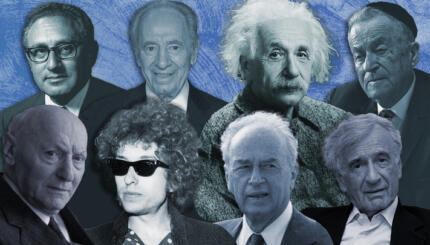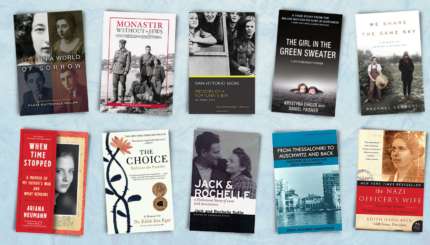Intermarriage has long been a focus of those concerned with continuity in the Jewish community. But what about the next generation(s)? The children and grandchildren of the intermarried? Do they practice Judaism? And, if so, what form does their practice take? Interfaith families were the focus of two 2001 surveys on the formation of religious identity; the following article outlines the results. It is reprinted with permission from The Jewish Week.
Two new surveys are shedding light on the religious lives of interfaith families and their children, but what kind of light depends on which side of the intermarriage debate you’re on.
Dueling Surveys
An American Jewish Committee-sponsored survey found that the great majority of mixed‑married households that identify as Jewish incorporate substantial Christian celebrations into their family lives, compared to only a tiny proportion of inmarried families.
 A Jewish Outreach Institute informal, self‑selecting poll of college students who are the products of interfaith marriages found that 64 percent of respondents were raised Jewish (23 percent Christian); that 81 percent now identify as Jewish (3 percent Christian); and that 69 percent attend Jewish religious services on campus, while 6 percent attend Christian services. The poll was conducted in partnership with the student group Lights in Action.
A Jewish Outreach Institute informal, self‑selecting poll of college students who are the products of interfaith marriages found that 64 percent of respondents were raised Jewish (23 percent Christian); that 81 percent now identify as Jewish (3 percent Christian); and that 69 percent attend Jewish religious services on campus, while 6 percent attend Christian services. The poll was conducted in partnership with the student group Lights in Action.

Help us keep Jewish knowledge accessible to millions of people around the world.
Your donation to My Jewish Learning fuels endless journeys of Jewish discovery. With your help, My Jewish Learning can continue to provide nonstop opportunities for learning, connection and growth.
The AJCommittee champions the “inreach” approach, which promotes inmarriage, while the JOI supports the all‑inclusive “outreach” philosophy.
The surveys–the first in nearly two decades–expand on the last look at religious identity formation in mixed‑married homes, which found that 25 percent of children from interfaith homes had an exclusively Jewish identity. That study was carried out for the AJCommittee by Egon Mayer, now the director of research for the JOI.
The 1990 National Jewish Population Survey showed that one‑third of children in mixed‑married households were being brought up as Jews. In the last decade, however, outreach programs run by the Jewish community have been a growth industry.
The new surveys reveal that a majority of children from interfaith homes identify as Jewish by the time they reach college, but that what that Judaism looks like may be different from anything ever seen.
The AJCommittee’s Department of Contemporary Jewish Life, headed by Steve Bayme, and the JOI are engaged in a quiet battle over which approach will hold sway at communal organizations and among philanthropists. The leaders of both groups believe that theirs is the only approach that will assure Jewish continuity.
Not surprisingly perhaps, the surveys by the two organizations reached divergent conclusions about the ability of interfaith marriages to produce children with strong Jewish identities.
The AJCommittee study of religious identity formation in interfaith families was conducted by social scientist Sylvia Barack Fishman of Brandeis University and included interviews with 254 people in mixed married, inmarried and conversionary households. The study, conducted between the spring and fall of 2000, also included four focus groups of teenagers growing up in interfaith families in northern New Jersey and in Denver, Colo.
The upshot of the AJCommittee study, according to Barack Fishman, is that “we really don’t know what the impact of this proportion of kids being clearly given dual religious identities will be on the larger American Jewish community.”
Despite “all of our previous hope and speculation that there was a significant proportion of children in mixed‑married households with an exclusively Jewish identity, this research demonstrates that this is not the case,” she said.
Findings
Some key findings of the AJCommittee study:
 · 63 percent of children in mixed‑married homes are being raised Jewish; 4 percent are being raised as Christian; 19 percent in two religions; 9 percent divide the children, raising some as Jews and others as Christians; 5 percent raise children in neither parents’ religion.
· 63 percent of children in mixed‑married homes are being raised Jewish; 4 percent are being raised as Christian; 19 percent in two religions; 9 percent divide the children, raising some as Jews and others as Christians; 5 percent raise children in neither parents’ religion.
· Mixed‑married households that initially try to create exclusively Jewish observances often drift increasingly into Christian activities and can end up with a kind of syncretistic blend.
· Jewish mothers, in general, create much more Jewishly identified mixed‑married households than do Jewish fathers. Seventy‑two percent of children being raised as Jewish have a Jewish mother.
· Many Jewish partners in mixed marriages report feelings of personal conflict between their desire to raise Jewish children and their desire to be fair to their spouses.
·Non‑Jewish spouses raising Jewish children often later found themselves resenting the fact that they had given up Christmas and other Christian celebrations.
· Both Jews and non‑Jews in mixed marriages tend to describe Jewish activities as “different” or “religious” while they call Christian activities “just cultural” and “fun.”
· The religion of the current spouse is related to the friends one chose in college.
· Parental messages count. Most of the Jews who married other Jews had parents who communicated an expectation that their dates be Jewish. Most of those in the study who intermarried received little or no guidance from their parents. Few respondents reported any backlash of resentment against parents who encouraged dating and marrying only Jews.
“Pressure has a demonstrated positive effect,” Barack Fishman told The Jewish Week in an interview from Jerusalem, where she was on sabbatical.
Many parents are reluctant to raise this issue with their teen and adult children, she said. “They do talk to their kids about things that they have unambivalent feelings about, about choosing colleges and careers, about drugs and about sex. But a lot of parents have internalized this notion that there’s something wrong with encouraging their children to exclusively date Jews and marry Jews,” Barack Fishman said.
“You see the parental confusion playing itself out in messages which are given, and not given, to the kids. What they say makes a big difference.”
“The Jewish community really needs to start getting this message across, that parents need to think it’s important enough to talk about, and to feel unambivalent about, to talk to their kids at various ages, just as they talk to their kids about sex at various ages,” she said.
Young Adults
The Web poll of children of interfaith marriages run by Lights in Action for the J0I received 205 responses from college students after being advertised last year in campus newspapers at New York University, Cornell and the universities of California at Berkley, Maryland, Michigan and Penn.
These young adults reported that:
· 58 percent had a bar or bat mitzvah, and 17 percent were baptized.
· 63 percent have participated in or currently are participating in Jewish youth groups, while 26 percent have participated in or now are participating in Christian youth groups.
· Almost all of the respondents–95 percent–said the religious differences in their upbringing contributed to their feeling uncomfortable in synagogues.
· 31 percent wish they had been given more Jewish education.
· 20 percent wish they had been brought up in only one faith, while 15percent wish they had been brought up in both faiths of their parents.
These findings “recognize the challenges that are implicit in nurturing Jewish identity within the context of interfaith marriage,” said Kerry Olitzky, executive director of JOI. “It means that the community may have to work harder, but that it’s also possible” to accomplish raising children with strong Jewish identities in interfaith households.
The AJCommittee’s focus‑group research with roughly this same age group—teenagers–found that many teens from mixed‑married families described fluid religious boundaries in their homes, with their families celebrating the major religious festivals of both Judaism and Christianity.
The message there is that “religion is a matter of choice, and a choice that can be made and changed as frequently as one desires,” said Barack Fishman in her report. “Children are often sent a clear message that religious choices are not too serious or momentous.”
Yet “children sometimes find religious expression powerful and meaningful despite the casualness of the religious environments that surround them,” she wrote. “Ironically, Jewishness is perceived by some teenagers as preferable to Christianity and also preferable to secularism or atheism precisely because it is different.”
Barack Fishman said that while the majority of the children of mixed married families may find Judaism less appealing because of its marginality, for some teens it is Judaism’s distinctiveness that makes them lean toward committing to a Jewish identity.
“We need to take seriously the imperative to try and enhance the possibility that people will marry Jews and establish Jewish households,” she said.


